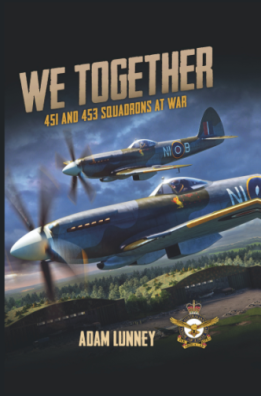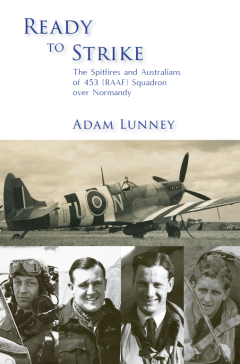We Together: 451 and 453 Squadrons at War
 This is not a tale of fighter aces shouting “Tally-Ho” and shooting down every plane in sight. It is the history of a group of men who were bonded by war and their love of flying. 451 and 453 (RAAF) Squadrons were both formed in 1941 and would both fly and fight until the end of the Second World War. While 451 was sent to North Africa and equipped with Hurricanes, 453 was deployed to Singapore, flying Brewster Buffalos against the Japanese.
This is not a tale of fighter aces shouting “Tally-Ho” and shooting down every plane in sight. It is the history of a group of men who were bonded by war and their love of flying. 451 and 453 (RAAF) Squadrons were both formed in 1941 and would both fly and fight until the end of the Second World War. While 451 was sent to North Africa and equipped with Hurricanes, 453 was deployed to Singapore, flying Brewster Buffalos against the Japanese.
Later they would both join the war in Europe, flying sorties together against V2 sites and dive-bombing targets ahead of the Allied advance. There are moments of excitement, pain, suffering, fear, boredom and laughter. Many families of the pilots involved do not even know the full story of the squadron. This book is not just the history according to the official record, but is the history informed by all available sources.
Now available in bookstores or from online sellers, such as Book Depository, Amazon and Booktopia.
Read a review of We Together on p. 74 of RAAFA Wings Magazine here.
Listen to a review on Episode 247 of The 2 Half-Squads podcast here.
Read a review of We Together by Aircrew Book Review here.
Ready to Strike: The Spitfires and Australians of 453 (RAAF) Squadron over Normandy
 Ready to Strike is the story of the only Royal Australian Air Force squadron to operate from airfields built immediately behind the front lines of the Normandy battlefield after the landings in France of June 1944.
Ready to Strike is the story of the only Royal Australian Air Force squadron to operate from airfields built immediately behind the front lines of the Normandy battlefield after the landings in France of June 1944.
453 (RAAF) Squadron was a ‘for war only’ formation. Ready to Strike covers the period from the Squadron’s formation in May 1941 to the end of the Normandy campaign in August 1944.
This group of men were bonded by war and their love of flying. There are moments of excitement, pain, suffering, fear, boredom and laughter.
The experiences and operations of the squadron are presented in detail, using many quotes from the pilots and data from their logbooks. The book is fully referenced with chapter end notes and a bibliography.
The Australians were in Normandy too – this is their story.
Highly Commended in the Literature Division of the 2018 RAAF Heritage Awards.
Visit Echo Books’ website for details on how to order Ready to Strike, or contact Adam directly for signed copies.
Reviews of Ready to Strike
NSW Police News magazine (December 2018) – Review by Ted Bassingthwaighte
On the 6th of July 1944 RAAF Squadron 453 pilot Norm Baker was on an armed recce over Normandy in his Spitfire (MK260) when he strafed an enemy truck from a very low height. His plane was hit by shrapnel and he crashed landed only just avoiding the waiting Germans. Over the next six weeks until he escaped to the Allied lines he was hidden in plain sight by French civilians as he pretended to be deaf and mute as a result of shell shock. Baker’s incredible luck to survive and fight again is but an addendum to the complete history of the role RAAF Spitfire Squadron 453 played in the lead-up to D-Day on Normandy and the crucial months after the landing.
Ready to Strike is Adam Lunney’s first book and what a spectacular start to hopefully many more historical tomes. The depth and breadth of the research and detail in this military history is breath-taking. He retells the story of the many courageous, mainly Australian pilots and ground staff in Squadron 453 recovering from almost total annihilation by the swarming Japanese in Burma and Singapore. Reformed in England in preparation for the liberation of France on June 6, 1944 Lunney reveals to the reader the very personal lives of many of the Australian pilots practicing in the Spitfires and occasionally dyeing in training accidents. The uncompromising bravery of these men is unforgettable.
Lunney also gives the reader a complete understanding of the Spitfire from its genesis to the crucial part the aircraft played in the changing the tide of the war. His man crush on the Spitfire is apparent as is his respectful, accurate and exhaustive particularizing of the lives and at times death of the men of Squadron 453. Lunney brings the men back to life through their letters home to family and from many, many Personal Combat Reports the pilots filed following their individual missions or ‘sorties.’ The laconic tone of some of these reports detailing the death and destruction of the enemy and sometimes the witnessing of the loss of their own is gripping reading.
But war is hell and Squadron 453 was not spared from the misery of it. Between June 1942 and August 1944 20 pilots were killed in training accidents or by friendly fire and by the enemy. After an almost unopposed number of missions over the Normandy beaches from June 6 to 11, 1944 Squadron 453 continued to patrol the sky over western France.
On a sortie on June 11 Henry Lacy Smith of San Souci, Sydney was flying his Spitfire (MJ789) over Caen when it was hit by flak. He radioed, ‘I’m going to have to put this thing down in a field.’ The plane was seen by other pilots to crash into water in the Orne estuary and flip over onto its back. Smith was not sighted after that.
Sometime later he was presumed dead. His English wife of a few months, Edna was given the bad news as was his family in Sydney. But 66 years later in 2010 a French family saw part of the tail of Smith’s plane poking out of the water at low tide. Henry was discovered in the cockpit, drowned. His body was recovered and given a full Military funeral and now lays at rest in Normandy.
Interestingly, the 453 Squadron crest includes a Kookaburra perched on high, alert for prey below. The crest motto, Ready to Strike, perfectly captures the spirit of the men of Squadron 453. Lunney ‘s faithful retelling of their complete history makes your heart swell with pride.